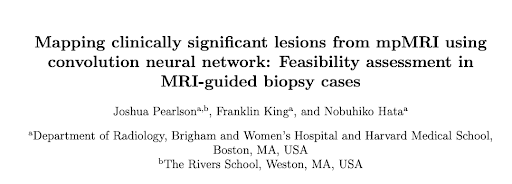Josh Pearlson - Dr. Nobuhiko Hata Surgical Navigation and Robotics Laboratory
- The Rivers School

- Sep 4, 2020
- 2 min read
This summer I interned with Dr. Nobuhiko Hata of the Surgical Navigation and Robotics Laboratory, a joint operation with Harvard Medical School and Brigham Women’s Hospital. Due to the restrictions of the coronavirus pandemic, laboratories in the hospital were forced to limit the number of people allowed inside. Instead of entering the lab, my internship moved online.

I previously had experience coding but this paled in comparison to the experience and skill I saw around me at the lab. To catch up to others I had to learn the basics of new languages Python, R, and Matlab. During the start of the internship, we went over the basics of lab operations. This included how to receive grant money from the NIH (National Institute of Health) and make the money last over a 20 year period while creating a medical device.
Next, we began a journal club and IRB training. In the journal club, we read many emerging scientific studies. We even got to hear from some of the scientists whose papers we read and reviewed in class! IRB (International Review Board) training is all about how to safely and ethically perform human studies in a lab.
Finally, towards the end of the internship, we were assigned individual projects to work on. My project was to create a way to turn an artificial intelligence model, which assesses the likelihood of prostate cancer from MRI images, into a heatmap of points. To do this, I had to code the model to loop through an MRI image assessing each point and then output the data into an array of the same size. This heatmap would offer a second opinion (of sorts) to radiologists when trying to assess biopsy need and or location. After completing my project, I co-wrote a paper with two other members of the lab about my results and findings. This paper was submitted to a medical imaging conference SPIE-Medical Imaging.
Over the course of my internship, I learned how to be resilient. I would often be stuck in segments of code and would have to read through volumes of online forums to learn what I needed. An example of this is when I had to install a deep learning program TensorFlow directly on to my computer's GPU (graphics processor). Doing this took a full day of research and reading up on compatibility charts, versions of programs that work together, for the applications that were needed. This resilience panned out well as I was able to see my project to completion. I am thankful for the opportunity to have worked at the Surgical Navigation and Robotics Laboratory. I am especially grateful for Dr. Nobuhiko Hata, and Mr. Schlenker for organizing this internship.







Comments